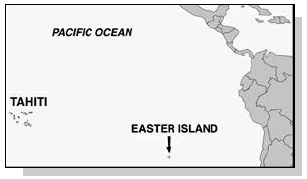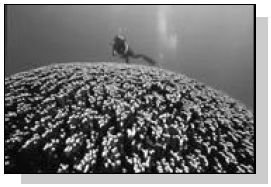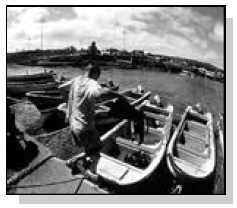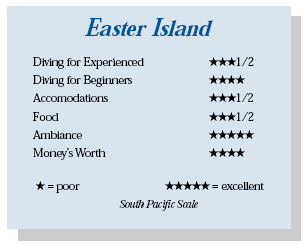Easter Island, South PacificContents of this Issue: Breakbone Fever: almost like the bends No Conclusions in Belize About Wave Dancer Deaths Five Personal Caribbean Favorites Equipment in Diver Accidents and Deaths: Part II Editorial Office: Ben Davison Publisher and Editor Undercurrent 3020 Bridgeway, Suite 102 Sausalito, CA 94965 gin-clear water, archaeology galore from the June, 2002 issue of Undercurrent
Dear Fellow Diver: To many travelers, the stone statues of Easter Island are reason enough to travel there. After all, the Moais, as they are called, stand more than twenty-five feet high and weigh up to fifty tons, and were mysteriously moved from where they were carved to various spots around the island. But to divers, the underwater mysteries may be just as unique. One of our reviewers traveled to Chile’s Isla de Pascua (or, in the native tongue, “Rapa Nui” or “Te Pito te Henua” -- the world’s belly button) to explore above and below. As it is 2,300 miles off the Chilean coast, and 2,300 miles south east of Tahiti, reaching this Polynesian island requires a long journey. Once there, however, you are sure to be enthralled by the archeological treasures and the unique diving in gin-clear waters. * * * * * * * * * Stepping off the plane, I smelled the dark, sweet air of the tropical night. After clearing customs I was met by Martin who, with his wife Anita, runs the Martin Y Anita Hostel where I would be staying. He greeted me in the Rapa Nui language and draped a flowered lei around my neck. Switching to English after entering his SUV, he told me about the island as we headed for the town of Hanga Roa. It was after 2 A.M. when I at last entered my room and passed out on the bed. The next morning dawned clear and windy. For the
first time I could inspect my room. The wallpaper was
faded and the furniture sparse. However, the double bed was
comfortable, the room was clean, and the well kept thirteenunit,
one-story, Spanish-style hotel was surrounded by a
lovely garden. From my e-mails, Martin knew I had come to dive. After I organized my camera gear, he drove me to the harbor, a small, protected cove with half a dozen dories. On the rise above the harbor’s entrance stood an ancient stone Moai, one of the famous Easter Island statues. Mike (pronounced “Mickey”) Rapu is a native islander, a world-class free diver, and owner of the Mike Rapu Dive Center, one of two scuba-diving concessions on this seven-by-fourteen-mile island. Big and hearty, he spoke no English, but his dive master Claudio Pena did. The dive center was small, but the equipment was well maintained. Rental suits and regulators hung on a wide rack in an open room with a small conference table and computer. They filled their tanks with a portable compressor near the entrance. After checking my C-card and experience, Claudio fitted me with a steel tank (5000 psi), BC, regulator, and weight belt (I brought my own mask, fins, and snorkel), all included in the $50/dive price tag. I had brought a light surf suit to dive in, which was comfortable enough for me, though the water hovered at 71 degrees, about the yearround temperature. After lunch, the staff loaded the dive gear on a cart and wheeled twenty feet to the edge of a concrete embankment lining the tiny harbor. They loaded it onto a traditional fourteen-foot wooden fishing dory outfitted with an outboard motor. Boatman Christian Saavedra maneuvered our craft out through the crashing surf (rough seas surrounding the island make beach diving impractical). My companions were a couple from Santiago. Like most Chileans and local island residents I met, they spoke a smattering of English, so communication was never a problem. Nearing our dive site, Claudio put on his mask and stuck his head under the surface to find a clear spot to anchor. After searching for a few moments, he motioned for us to stop and tossed over the anchor. One by one we entered the water. Christian handed me my housing and I followed Claudio into the deep. Conditions were murky and I wondered whether I had made a mistake coming here. Yet thirty feet later the cloudy water cleared and I entered a coral Eden. Thousands of individual stands of live coral blanketed the ocean floor, leaving little open space. No wonder Claudio needed a mask to find a spot to drop anchor. Surrounding us was the clearest, bluest water imaginable. Visibility exceeded one hundred feet. Swimming northward, I saw what appeared to be an enormous rock, but it was a huge sphere of coral, sixteen feet in diameter, named “Motu Kare Kare.” I moved under an overhang and out of the sun while the couple explored the other side. I turned on the underwater lights of my Ikelite strobes and examined the ceiling, a honeycomb of porous volcanic rock. Red and white stripped soldier fish darted between the rocky pockets. I swam out into the light and hovered above the coral summit. Tiny purple damselfish scooted between the coral fingers as I approached. With 700 psi left, I worked my way to the surface, handed up my gear, and climbed over the gunwales to get back into the dory. I dived several more days with Mike Rapu’s friendly crew. They were helpful to me and inexperienced divers, friendly, and made sure I went to the best dive sights. Still, it was time to talk to the other guy. Henri Garcia and his younger brother Michel were the first to start a dive business on Easter Island. A former Jacques Cousteau diver, Henri came to the island in 1976 on the Calypso to film the underwater landscape for a TV special. Michel joined him later and they have since expanded their business to include kayaking and surfing. Their operation is more upscale than Mike Rapu’s, with an inside compressor, more equipment, and a repair shop in a larger building with a sink outside for photographers to wash off their equipment. They used fourteen-foot dories and small Boston Whaler style boats for diving. Henri was in Europe when Michel took Chilean filmmaker Rodrigo Fernandez and
me to the slender rock formation of Motu Kao Kao on the island’s southwest shore. I crossed the rough sea standing on the bow of
Michel’s boat, clinging to a rope like a
Roman charioteer. Circumnavigating the pinnacle, we passed hundreds of coral heads decorating the vertical face. Sharp sea urchin spines bristled at us from dark cracks. Yellow and black-backed butterfly fish roamed the wall. A spiny lobster peeked out from a hole in the rock, its antennae waving at us from the darkness. Unique plate corals overhung like store awnings, the undersides a deep green or vibrant red. Above us, the surf of the open sea crashed at the surface. Dark silhouettes of passing fish crossed a V-shaped gulf, each waiting for the rough water to subside. After turning a sharp corner we came back to our boat, where Michel kept us at ten feet for several minutes to off-gas. I clung to a handhold on the rock while Rodrigo hovered in the open water a few feet away. A school of gray chubs swam in the distance and Michel went to join them. The fish parted like a living curtain, making lazy swirls around Michel, then, as if by a silent signal, they rejoined and swam away. A few minutes later we were in the boat and heading back to Hanga Roa. I mentioned to Michel that Moto Kao Kao would make a great night dive. He said he could arrange it if I wanted. Of course, Easter Island has some of the greatest archeological sites on the planet. Most hotels can arrange a tour for $35. I went on my own, renting a late model SUV for $50 per day. A single paved road circumnavigates the island. I got some dawn photographs at Ahu Tongariki, whose fifteen giant Moais stand on an elevated platform overlooking the sea. Nearby, lying on their side, were reddish-hued stone topknots. Weighing several tons, they are representations of the way native islanders wear their hair -- tied at the top of the head like a ball -- and once rested atop the heads of the Moais. Each day I followed a comfortable routine. After breakfast I would ready my
gear, then take a taxi to the harbor and dive two or three tanks with either Mike
or Michel, depending on where they were going that day. Diving is best from
September to April (it can be rainy and rough the other months). I was back to
shore by 6 P.M. each day. This was November, early in the season, and there weren’t
many people, so I could usually choose where to go. (Both operations say they handle
as many as ten divers per trip for four dives a day. But on these dories?)
Forty percent of the people I dived with were Chileans, followed by French from
nearby Tahiti, English, Swiss, Austrian, and Japanese. Most were inexperienced or only casual divers, yet they were well
taken care of by the guides. Several open-air restaurants cluster around the harbor, all pleasant in the high, eighty-degree nights (and no mosquitoes). The food was more continental than south-of-the-border not at all hot or spicy. My favorite lunch was a grilled fresh tuna steak sandwich with French fries and a coke, for U.S. $8. Dinner menus had good Chilean meats, pasta, excellent fresh seafood, salad, and seafood appetizers, and good Chilean wine. Though traveling alone, I never ate alone, joining other tourists I met. One night, we ate at a fancy restaurant with a full bar and white-coated waiters. The meal was lamb in a rich gravy-like sauce, potatoes, fresh kiwi fruit, and French wine. I visited a few discos, nothing too crazy, and I learned to appreciate a properly mixed pisco sour. On my last day, Mike Rapu wanted to take me someplace special. With Claudio and three Australians in tow I followed Mike down a reef formation called the Pyramid. At 120 feet, my deepest dive of the trip, we swam slowly under a hidden overhang called “the Lost Arch.” I turned on the lights of my strobes and the cave walls glowed a pink fluorescence from a coating of hard calcium. Searching a dark hole, stealthy glasseyes moved in and out of the narrow beam of light, uncomfortable at my intrusion into their world of darkness. With Claudio leading the way, we filed out over a series of broad ledges, passing a beautiful spotted moray eel coiled in a pocket of rock. We exited at a vertical opening at the ceiling. Reaching the summit of the pyramid we crossed an expanse of open water to the anchor line. Below us, beautiful sunset wrasses moved from coral to coral. Trumpetfish swam in open water and sleek amberjacks streaked through the crystal clear water. Indeed, Easter Island is a unique destination, with plenty of comforts, unique diving and archeology, educated and interesting people, and a few surprises. One day I was sitting in the small conference room in Mike Rapu’s dive shop when a guy out of an old south sea’s movie walked in. He was naked except for a loincloth draped around him. He had long scraggly hair and an unkept beard. Without a beat he sat down at the store’s computer, went on line and started typing. Easter Island is filled with surprises. A day doesn’t go by that I don’t think of that place. The incredible ball of coral called Kare Nui Nui. The golden sunrise on the Moais of Aku Tongariki. The stone tower of Motu Kao Kao surrounded by that blue water. And the bluest water I’ve ever seen. -- M.C. |

I want to get all the stories! Tell me how I can become an Undercurrent Online Member and get online access to all the articles of Undercurrent as well as thousands of first hand reports on dive operations world-wide
| Home | Online Members Area | My Account |
Login
|
Join
|
| Travel Index |
Dive Resort & Liveaboard Reviews
|
Featured Reports
|
Recent
Issues
|
Back Issues
|
|
Dive Gear
Index
|
Health/Safety Index
|
Environment & Misc.
Index
|
Seasonal Planner
|
Blogs
|
Free Articles
|
Book Picks
|
News
|
|
Special Offers
|
RSS
|
FAQ
|
About Us
|
Contact Us
|
Links
|
3020 Bridgeway, Ste 102, Sausalito, Ca 94965
All rights reserved.

 For $50 a night I got maid service and
breakfast with other guests in a common room with hot tea fresh orange juice, muffins, and conversation.
For $50 a night I got maid service and
breakfast with other guests in a common room with hot tea fresh orange juice, muffins, and conversation. It was too deep to anchor,
so Michel tied our boat to a horn of rock
jutting from a pinnacle that towered 450 feet
above. Svelte, black frigate birds orbited
the narrow summit, casting a dark shadow on
the rolling surface like the needle of a
giant sundial. Once in the water, I couldn’t
believe my eyes. Visibility was easily 200
feet! Rodrigo and I followed Michel down the
steep rock wall, leveling off at seventy feet,
from where I could see the boat above and the
bottom below. Twenty-five percent of Easter Island marine life is endemic and,
oddly, there are few sharks or dangerous marine animals like stonefish, lionfish,
cone shells, or box jellies. Nor are fish plentiful; in fact, I saw but twenty-five
species in all my dives. The highlight is stunning hard coral and gin-clear waters.
It was too deep to anchor,
so Michel tied our boat to a horn of rock
jutting from a pinnacle that towered 450 feet
above. Svelte, black frigate birds orbited
the narrow summit, casting a dark shadow on
the rolling surface like the needle of a
giant sundial. Once in the water, I couldn’t
believe my eyes. Visibility was easily 200
feet! Rodrigo and I followed Michel down the
steep rock wall, leveling off at seventy feet,
from where I could see the boat above and the
bottom below. Twenty-five percent of Easter Island marine life is endemic and,
oddly, there are few sharks or dangerous marine animals like stonefish, lionfish,
cone shells, or box jellies. Nor are fish plentiful; in fact, I saw but twenty-five
species in all my dives. The highlight is stunning hard coral and gin-clear waters. Nearby is the volcanic cone of Rano Raraku
where these monoliths were quarried. Differentsized
Moais are strewn around the base of the
peak, some unfinished and still part of the living
rock. An occasional ranger may appear to answer
questions and prevent vandalism, but none of these
sites is fenced, so you are free to roam and
explore. One can also hike the more isolated
parts of the island. Along the northern part,
caves a hundred feet above the water exit along
the sea. In ancient times, native islanders used
the caves to hide from slavers. In one cave I saw
a skull that had been mounted on a ledge a hundred
years ago. The only town, Hanga Roa, has four
thousand people. It’s made up of modest yet comfortable homes, a few churches, and no big buildings. The homes and businesses are
mixed together, but most businesses are near the water. One can walk the length of
the town in an hour or ride anywhere by taxi for $1.50.
Nearby is the volcanic cone of Rano Raraku
where these monoliths were quarried. Differentsized
Moais are strewn around the base of the
peak, some unfinished and still part of the living
rock. An occasional ranger may appear to answer
questions and prevent vandalism, but none of these
sites is fenced, so you are free to roam and
explore. One can also hike the more isolated
parts of the island. Along the northern part,
caves a hundred feet above the water exit along
the sea. In ancient times, native islanders used
the caves to hide from slavers. In one cave I saw
a skull that had been mounted on a ledge a hundred
years ago. The only town, Hanga Roa, has four
thousand people. It’s made up of modest yet comfortable homes, a few churches, and no big buildings. The homes and businesses are
mixed together, but most businesses are near the water. One can walk the length of
the town in an hour or ride anywhere by taxi for $1.50. I only dove
with one American in two weeks there.
I only dove
with one American in two weeks there. Divers Compass: Travel from Monterey CA, through Los Angeles
and on to Lima Peru, Santiago, and Easter Island took twenty
hours ($1700 for the RT ticket). Many visitors to Tahiti visit
as a sidetrip; a four day flight/hotel package runs about $1500
upwards, depending upon the quality of the hotel (there are
several to house the 20,000 tourists who visit annually). . .
The guides were careful to question clients about their experience
and make sure they didn’t overextend themselves; the
guides carried portable radios in waterproof containers so wewere always in contact with the island. The
island has no recompression chamber; bent
divers are transported to Santiago or
Valparaiso on a LanChile airline ... You can
use Mike’s computer for e-mailing at $1.50
per fifteen minutes ... You can buy film on
the island ... Everybody takes U.S. dollars
and gives back change in pesos. To drive,
one is supposed to have an International
Drivers License (you can get one at the AAA
for $10), though no one on the island asked
me for one. Martin Y Anita Hostel:
Divers Compass: Travel from Monterey CA, through Los Angeles
and on to Lima Peru, Santiago, and Easter Island took twenty
hours ($1700 for the RT ticket). Many visitors to Tahiti visit
as a sidetrip; a four day flight/hotel package runs about $1500
upwards, depending upon the quality of the hotel (there are
several to house the 20,000 tourists who visit annually). . .
The guides were careful to question clients about their experience
and make sure they didn’t overextend themselves; the
guides carried portable radios in waterproof containers so wewere always in contact with the island. The
island has no recompression chamber; bent
divers are transported to Santiago or
Valparaiso on a LanChile airline ... You can
use Mike’s computer for e-mailing at $1.50
per fifteen minutes ... You can buy film on
the island ... Everybody takes U.S. dollars
and gives back change in pesos. To drive,
one is supposed to have an International
Drivers License (you can get one at the AAA
for $10), though no one on the island asked
me for one. Martin Y Anita Hostel: 